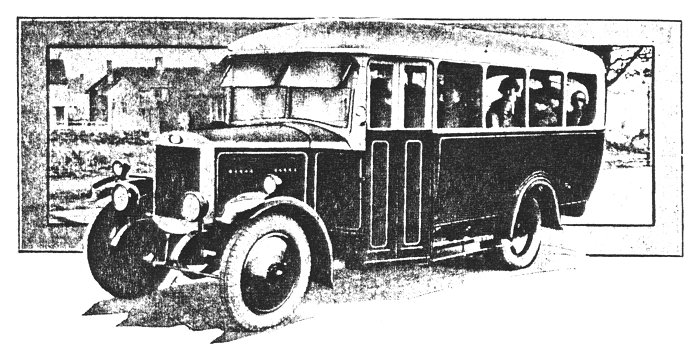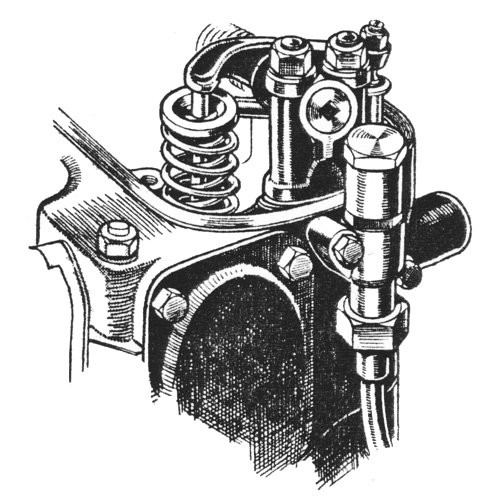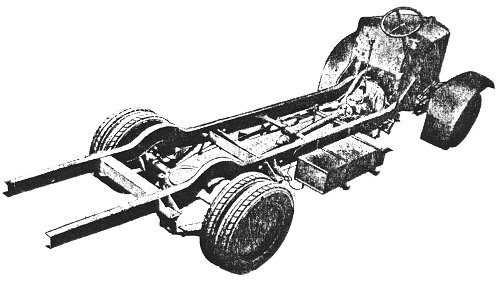|
The Fast
20-Seater; What Guys are Doing
An article from 'The
Commercial Motor', 30th October 1928. Courtesy of Brendan Kinsella. |
|
The New OND
Model Guy is a Robust Product at a Moderate Price
Much attention has been given during recent
years to the development of the large capacity coach and bus
capable of travelling at much higher average speeds than were
formerly possible, and it seems that the smaller passenger
vehicles have been somewhat neglected. For this reason the
latest product from the Wolverhampton works of Guy Motors,
Limited, should, receive a warm welcome from those users and
potential users of vehicles of moderate capacity.
Even a cursory inspection of the new OND
model Guy chassis will reveal the fact that it is no ordinary
semi - converted goods model, but one designed expressly for the
purpose which it is called upon to serve, including as it does,
an extremely powerful and live engine, a frame dropped at the
dash and arched over the rear axle, Dewandre-operated
front-wheel brakes, and a most complete equipment. |
|

A 20-seater bus in which the new Guy
chassis is used. |
|
Road tests, with this model, fully laden;
have revealed a surprising turn of speed. The vehicle speed at
1,000 rpm. of the engine is 18.8 mph. and the engine is easily
capable of 8,000 rpm.; actually 49 mph. has been obtained with
ease. Gear changing is finger-light, the steering easy and
affording an excellent lock; furthermore, long, fairly stiff
gradients can be climbed on top gear and on the lower speeds
little more than a faint hum can be heard.
The following are the main dimensions,
etc.: Engine four cylinders, 90 mm. bore and 130 mm. stroke,
rated at 20 hp.; gear ratios, top, direct, third, 1.7 to 1,
second, 2.61 to 1, first, 5.27 to 1, reverse 8.23 to 1; axle
ratio, 5.4 to 1; wheelbase, 12 ft. 3 ins: track, 4 ft. 9½ ins.;
overall length, 18 ft. 10 ins.; dash to end of frame, 14 ft. 8
ins:; frame height under load 2 ft.; ground clearance under
front axle, 12½ ins. under rear axle, 7¾ ins.; turning circle,
approximately 50 ft.; chassis weight approximately 35 cwt.
The frame is built up with side members 6
ins. deep with 2¼ ins. flanges, the material being ¼ ins. thick.
There is a deep, dropped cross-member at the front to carry the
forward pinion support of the engine-gearbox unit, and both
tubular and channel-section cross members elsewhere, two being
bolted right through to the pressed-steel rear spring brackets.
The suspension is by long semi-elliptic springs with bushed
eyes. Tecalemit-Zerk lubricating nipples are
utilized throughout the chassis. |

The forward end of the engine in the new
Guy, showing one of the rocker-operated valves, and the camshaft
oil lead containing the relief valve. |
In the power unit the four cylinders are
cast en bloc with the upper half of the crankcase and the head
carries the valves and rocker gear, which is operated by
push-rods from the camshaft in the crankcase.
The rockers carry
ball-ended adjustable pins working in oil cushioned cups on the
push rods.
Cast iron pistons, each with three ordinary
and one scraper ring, are utilised.
The gudgeon pins are dowelled into the
pistons and held by wide spring steel bands. White metal-lined
shells are fitted into duralumin connecting rods. |
| There are three main bearings for the extremely robust
crankshaft. Quietness is assisted by the use of helical timing
gears and a skew-gear for the cross-shaft, which drives a Lucas
magneto at the near side and a centrifugal-type water pump at
the other. There is a breather on the timing case and the dynamo can be
flange-fitted at either side. Circulation of the engine oil is effected
by a submerged pinion-type pump driven from the camshaft. The
oil enters a readily accessible external filler chamber from
which one lead takes it to the main bearings and thence through
the drilled crankshaft to the big ends, whilst a second lead
takes it to a relief valve chamber bolted to the cylinder head,
and from this to the hollow shaft carrying the rocker arms.
Distribution of the mixture from the triple-diffuser Zenith
carburettor is effected within the cylinders, but the exhaust
manifold is external. A hot-spot is embodied in the arrangement. |
|
The cooling water is circulated around a
gilled-tube, cast-aluminium radiator of pleasing design through
which air is drawn by a large cast-aluminium fan mounted on
ball-bell rings on an eccentric spindle and driven by an endless
rubberised-fabric belt. The bhp. developed is 23 at 1,000 rpm.,
34 at 1,500 rpm., and 38 at 2,000 rpm.
Twelve compression springs are utilised for
the single-plate clutch of the semi-steel flywheel, which is
totally enclosed in the engine-gearbox unit but can be examined
through an inspection hole provided with a steel cover.
|

Engine accessibility as exemplified in the
Guy. Note air cleaner. |
|
Four forward speeds are given by the
gearbox, which has short, stiff shafts and wide-toothed pinions
carried in a one-piece casting, in the cover of which is mounted
the selector mechanism. A particularly interesting feature is
that either central change or right-hand gear control can be
provided. In the latter case, the lever is mounted on a cast
aluminium extension of the gearbox cover. At the off-side of the
gearbox is a plate which can be detached to permit a power
take-off from the layshaft, whilst at the rear of the box on the
third motion shaft is the positive gear drive for the
speedometer.
|
|

A semi-plan view of the new OND Guy
passenger chassis. |
Behind the gearbox is a two-piece tubular
propeller shaft with three ply Hardy flexible fabric joints at
the forward end and a Spicer all-metal joint with a plunger at
the rear end, a centre bearing being provided.
A horizontal banjo forged casing of
exceptional strength is used for the rear axle, which is driven
by an underneath worm. All the wheels are carried on
taper-roller bearings.
|
|
The front axle is of the reversed Elliott
pattern with the truck rod at the front. This rod has ball and
socket joints, whilst the drag-link is provided with spring
loaded ball joints.
Duplex brake shoes are provided for the
rear wheel drums, one set of shoes being controlled by the hand
lever, whilst the other set is coupled up with the front brakes
and operated through the Dewandre servo. Spherical bushes on the
two cross-shafts prevent any risk of binding through frame
flexion. The brake drums are deep-flanged forgings with, dust
covers for the shoes and the hand brake is not compensated, so
simplifying the gear.
|
|
Brake adjustments are made by turnbuckles
and sprung snap-over wing-nuts at the extreme ends. At the near
side of the frame is mounted a 16-gallon petrol tank from which
the carburettor is supplied by an Autovac.
It is obvious that close attention has been
given to that vitally important point, accessibility. Inspection
covers are provided for the timing gear, Bendix pinion of the
starter, big-ends, etc., whilst the three-point mounted
engine-gearbox unit can easily be removed from the front.
Although the chassis we illustrate is
arranged for the normal driving position the company is quite
prepared to provide a chassis with forward control, and to
facilitate this, the engine is so designed that all its
auxiliaries are accessible from the near side, although the
dynamo can be mounted at the other side if desired.
The tyres provided as standard are 30 inch
by 5 inch twins at the rear, all on steel-disc wheels, a spare
wheel and tyre being included. As an alternative, 33 inch by 5
inch tyres can be provided at an extra cost.
|

The rear spring brackets are light but
strong. |
|
The chassis is designed to carry a net load
of 27 cwt., and the gross load, inclusive of body, must not
exceed 2 tons 5 cwt. With 12 volt, five lamp lighting set,
starter, speedometer, air cleaner, electric horn and Dewandre
servo, the chassis price is £445.
|
 |
Return to the
previous page |
|